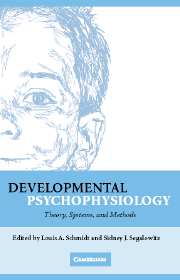Book contents
- Frontmatter
- Contents
- Foreword by Stephen W. Porges
- Preface
- Acknowledgments
- Contributors
- 1 Capturing the Dynamic Endophenotype: A Developmental Psychophysiological Manifesto
- SECTION ONE CENTRAL SYSTEM: THEORY, METHODS, AND MEASURES
- SECTION TWO AUTONOMIC AND PERIPHERAL SYSTEMS: THEORY, METHODS, AND MEASURES
- SECTION THREE NEUROENDOCRINE SYSTEM: THEORY, METHODS, AND MEASURES
- SECTION FOUR DATA ACQUISITION, REDUCTION, ANALYSIS, AND INTERPRETATION: CONSIDERATIONS AND CAVEATS
- 13 Psychophysiology Principles, Pointers, and Pitfalls
- 14 Obtaining Reliable Psychophysiological Data with Child Participants: Methodological Considerations
- Index
- References
14 - Obtaining Reliable Psychophysiological Data with Child Participants: Methodological Considerations
from SECTION FOUR - DATA ACQUISITION, REDUCTION, ANALYSIS, AND INTERPRETATION: CONSIDERATIONS AND CAVEATS
Published online by Cambridge University Press: 27 July 2009
- Frontmatter
- Contents
- Foreword by Stephen W. Porges
- Preface
- Acknowledgments
- Contributors
- 1 Capturing the Dynamic Endophenotype: A Developmental Psychophysiological Manifesto
- SECTION ONE CENTRAL SYSTEM: THEORY, METHODS, AND MEASURES
- SECTION TWO AUTONOMIC AND PERIPHERAL SYSTEMS: THEORY, METHODS, AND MEASURES
- SECTION THREE NEUROENDOCRINE SYSTEM: THEORY, METHODS, AND MEASURES
- SECTION FOUR DATA ACQUISITION, REDUCTION, ANALYSIS, AND INTERPRETATION: CONSIDERATIONS AND CAVEATS
- 13 Psychophysiology Principles, Pointers, and Pitfalls
- 14 Obtaining Reliable Psychophysiological Data with Child Participants: Methodological Considerations
- Index
- References
Summary
INTRODUCTION
Developmental psychophysiological research is a relatively young field that is rapidly expanding partly because sophisticated, cost-effective technology now allows researchers to collect physiological data much more efficiently and effectively. This volume of developmental psychophysiology reflects both the newness as well as the growth of the field. As alluded to by many of the authors included in this volume, researchers collecting valid psychophysiological data in children face challenges that are magnified when compared to the collection of these same data in adults. However, developmental psychophysiologists are not alone in addressing these challenges as we can readily draw upon the experiences from specialists working in other related fields.
The fields of psychology and education have also contributed to our general knowledge about effective methods of assessing children. Notably, the number of texts written on behavioral and neuropsychological assessment of children is plentiful, and we can apply this knowledge to assessment of psychophysiological information as well. For example, the recent editions of assessment of children (Sattler 2001, 2002) comprehensively discuss skills necessary for test administrators to have in order to successfully assess children. Some of these skills include effective listening, building rapport with the child, and how to handle difficult behaviors and individual temperaments. A researcher who develops these assessment skills discussed by psychologists, neuropsychologists, and education professionals, along with the technical skills necessary for obtaining the desired psychophysiological measurements will be much more successful in obtaining reliable and valid research data.
- Type
- Chapter
- Information
- Developmental PsychophysiologyTheory, Systems, and Methods, pp. 424 - 448Publisher: Cambridge University PressPrint publication year: 2007
References
- 3
- Cited by



